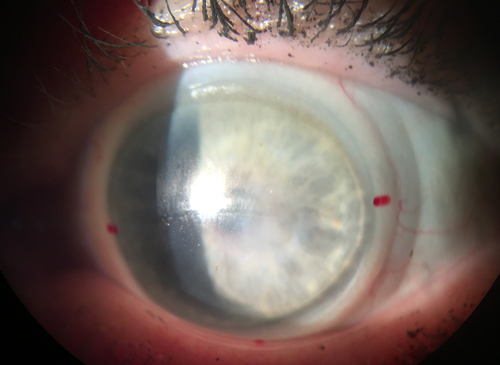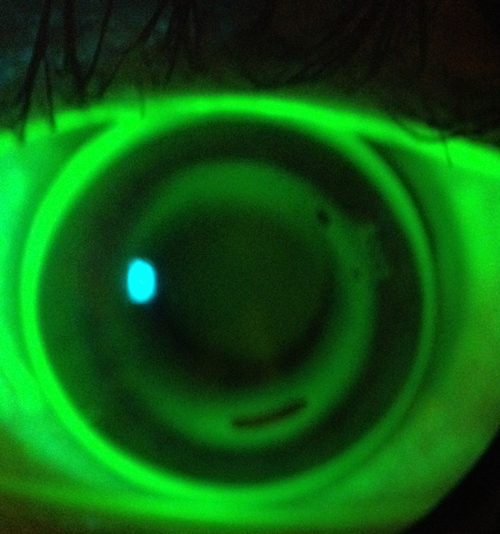 |
Rigid gas permeable (GP) contact lenses have long been a staple of the contact lens industry; however, when soft contact lenses (i.e., hydrogels and silicone hydrogels) took the industry by storm in the 1990s and early 2000s, there was talk of these hard lenses becoming extinct. Indeed, only an estimated 10% of all contact lens patients wear GP or hybrid lens designs, while the other 90% of wearers use soft contact lenses.1
In the face of such statistics and the continued evolution of soft lenses to better address patient needs, it is certainly pertinent to question the future of GP lenses. Innovations discussed at this year’s Global Specialty Lens Symposium, however, may shed light on some exciting new directions we’re headed in.
• GP Multifocals. At a panel on the future of multifocal contact lenses, GP lens guru Ed Bennett, OD, of the University of Missouri–St. Louis College of Optometry discussed recent GP lens trends—including the improvement of hybrid multifocals, the use of GP multifocals for post-refractive surgery patients, improved high-add aspheric multifocals and scleral multifocals—and predictions regarding their role in the clinical practice in the next few years.
Interestingly, Dr. Bennett pointed out that while practitioner preference for prescribing multifocals over other contact lens options has increased from 59% to 70% in recent years, many practitioners are still under-prescribing multifocal contact lenses.2 GP lenses are in fact a great option for both patients with irregular corneas and normal presbyopes, as they provide sharper vision and cost less over time compared with soft multifocal lenses. Some of the most recent innovative GP multifocals include Reclaim (Blanchard), Renovation (Art Optical), Clarity Plus (Accu Lens) and GoldenEye AFM (Valley Contax). These newer designs can be ordered empirically and, more often than not, the first or second lens ends up being the final lens. If you have a patient who appears to be a good GP multifocal candidate, don’t be scared to try some of the latest designs—you might be pleasantly surprised at the results.
• Myopia Control. Brien Holden, PhD, CEO of the Brien Holden Vision Institute, stressed in his presentation how significant a problem myopia is worldwide, and that it is the responsibility of eye care professionals to educate patients about the risks of high myopia and available treatment options. In North America, about one-third of individuals were myopic in 2000; this number is expected to increase to 50% by 2030 and 60% by 2050.2 Even more concerning than this percentage increase, however: the risk of certain debilitating, blinding eye diseases increases with high myopia and—this issue is still not being recognized and addressed properly.
 | |
| Fig. 1. Orthokeratology lens with a bubble in the return zone. This is an easy problem to solve. |
Both soft and rigid contact lenses are available to control myopia: soft lenses such as center-distance multifocals and inverted high minus lenses worn overnight, while GP options include the iSee (GP Specialists) DreamLens (Bausch + Lomb), CRT (Paragon) and Gov series (Global OK-Vision) orthokeratology lenses (Figure 1).3
• Hybrid Lenses. Hybrid lens technology, which has experienced some great design advancements in recent years, offers patients the optics of a GP lens with the comfort of a soft lens. The Duette hybrid lens (SynergEyes), which features a silicone hydrogel skirt and a high dK GP center, is one such example available for single vision (Duette HD) and presbyopic (Duette Progressive and Duette Multifocal) patients. SynergEyes also offers the UltraHealth hybrid lens to treat keratoconus, and will soon be releasing the UltraHealth FC hybrid lens for oblate corneas due to certain diseases or following radial keratotomy or LASIK procedures.
• Scleral Lenses. Scleral contact lenses are undoubtedly one of the hottest topics in GP lenses—in fact, most laboratories have their own proprietary scleral lens design. When scleral lenses re-emerged in 2006, the first designs were primarily spherical (i.e., spherical base curves, secondary curves and edges). Practitioners fitting these lenses, however, discovered that certain adjustments were necessary to achieve a perfect fit due to the toric nature of many patients’ scleras; thus, peripheral curves and toric haptics can now be changed, and some scleral lens designs are available in a front surface toric design for patients with residual astigmatism (Figure 2).
 | |
| Fig. 2. Scleral lens with front toric markings. |
In my experience, I have found that most of the front surface toric scleral lens designs are not as stable as I would prefer, and the vision has not been optimal in several of my patients, but I know that all of the laboratories are working on improving their toric stabilization systems, and I am confident that in the future, the designs will be much improved. For example, many scleral lenses on the market are now available with a multifocal option for presbyopic patients, which is a great option for irregular cornea patients looking to reduce their dependence on reading glasses.
While for some patients, GP lenses are a first choice for refractive correction, for many others, they are a reluctant last resort after all other options have been exhausted. As technology continues to improve, however, I believe that these remarkable lenses will increasingly become one of the patient’s top choices instead. Rumors of their death have been greatly exaggerated!
1. Andre, M. Where have all the RGP wearers gone? Eyewitness. Third quarter 2002.
2. Nichols, J. Educational highlights from GSLS 2015. Contact Lens Spectrum, Volume: 30 , Issue: April 2015, page(s): 22-30, 55.
3. Daniels, K. Consider ortho-k for myopia control. Review of Cornea and Contact Lens. Jul 15, 2012.


